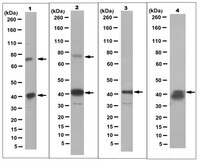Circulation research
van Berlo, JH; Elrod, JW; van den Hoogenhof, MM; York, AJ; Aronow, BJ; Duncan, SA; Molkentin, JD
Circulation research
107
1032-40
2010
요약 표시
The transcriptional code that programs maladaptive cardiac hypertrophy involves the zinc finger-containing DNA binding factor GATA-4. The highly related transcription factor GATA-6 is also expressed in the adult heart, although its role in controlling the hypertrophic program is unknown.To determine the role of GATA-6 in cardiac hypertrophy and homeostasis.Here, we performed a cardiomyocyte-specific conditional gene targeting approach for Gata6, as well as a transgenic approach to overexpress GATA-6 in the mouse heart. Deletion of Gata6-loxP with Nkx2.5-cre produced late embryonic lethality with heart defects, whereas deletion with β-myosin heavy chain-cre (βMHC-cre) produced viable adults with >95% loss of GATA-6 protein in the heart. These latter mice were subjected to pressure overload-induced hypertrophy for 2 and 6 weeks, which showed a significant reduction in cardiac hypertrophy similar to that observed Gata4 heart-specific deleted mice. Gata6-deleted mice subjected to pressure overload also developed heart failure, whereas control mice maintained proper cardiac function. Gata6-deleted mice also developed less cardiac hypertrophy following 2 weeks of angiotensin II/phenylephrine infusion. Controlled GATA-6 overexpression in the heart induced hypertrophy with aging and predisposed to greater hypertrophy with pressure overload stimulation. Combinatorial deletion of Gata4 and Gata6 from the adult heart resulted in dilated cardiomyopathy and lethality by 16 weeks of age. Mechanistically, deletion of Gata6 from the heart resulted in fundamental changes in the levels of key regulatory genes and myocyte differentiation-specific genes.These results indicate that GATA-6 is both necessary and sufficient for regulating the cardiac hypertrophic response and differentiated gene expression, both alone and in coordination with GATA-4. | 20705924
 |









